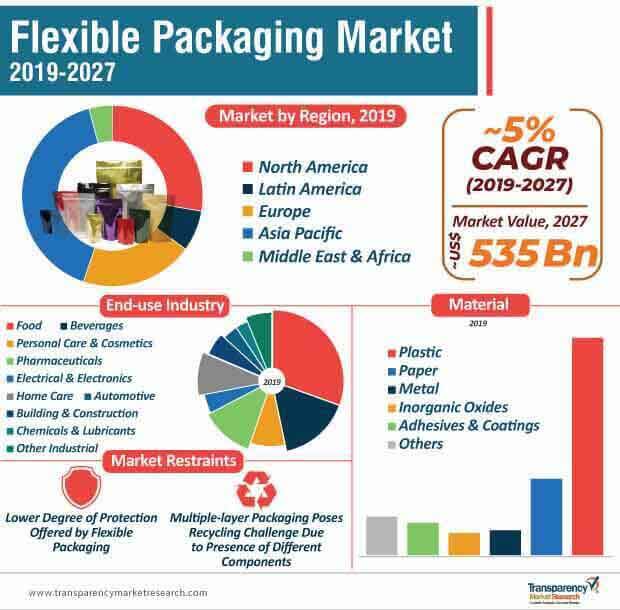
In recent years, the push to reduce the negative impact of certain types of packaging on the environment has had an influence on every industry, most notably packaging. In particular, stakeholders in the flexible packaging market are looking into the use of newer and different materials to align with this goal, including environment-friendly bio-based materials and biodegradable plastics. For instance, in July 2019, Huhtamäki Oyj launched compostable double-walled hot cups as a part of its Bioware product range – the Bioware Impresso, which utilizes 100% PEFC (Programme for the Endorsement of Forest Certification) certified paperboard, and use 25% less material that conventional cups that are double- and triple-walled.
This adoption of sustainable packaging and biodegradable raw materials also comes from shifting consumer trends, which is likely to have a positive impact on the growth of the global flexible packaging market. Bioplastics held a market share of ~US$ 3.8 Bn by value in 2018, and this segment is expected to grow at a CAGR of ~5% during the forecast years.

Request a sample to get extensive insights into the Flexible Packaging Market
Growing Demand from Food Sector to Boost Market Growth
The food sector has been the largest end user of flexible packaging, and in 2018, held a ~30% share of the global flexible packaging market. This is projected to rise over the forecast period at the rate of ~5%, and the food sector is likely to continue to hold the largest chunk of the revenue and sales in the market. This can be attributed to several benefits, including lowered production and transportation costs, customizable barrier properties, and protection of product integrity offered by flexible packaging.
However, the pharmaceuticals industry is quickly gaining significance in the flexible packaging market, projected to grow the fastest at a healthy pace of ~6% during the forecast period of 2019-2027. Customizable packaging, recyclability, and convenience are the major factors that have contributed to the growing popularity of flexible packaging in the pharmaceuticals sector.
Market in APAC to Expand Substantially
The increasing demand for flexible packaging from Asia Pacific has propelled the growth of the market in the region, which, in 2018, accounted for over one-third of the revenue share of the global market, and is expected to expand at ~6% during the forecast years. The growth of the flexible packaging market in APAC can be attributed to several factors, including the rise in per capita demand for packaging from developing countries, concentration of producers of flexible packaging in the region, and increasing demand for sachets and stick packets.
To understand how our report can bring difference to your business strategy, Ask for a brochure
However, the flexible packaging market in North America also occupied a significant share of ~28% in the global landscape in 2018, and is likely to grow at a CAGR of ~5% over the forecast period. Pouches, sticks, and sachets are expected to remain popular within the North America market, thereby driving its growth.
Competition Analysis
The global flexible packaging market landscape is considered to be fairly fragmented, with the top ten players – Amcor Plc, Winpak Ltd., Sealed Air Corporation, Sonoco Products Company, Berry Global Group, Inc., DS Smith Plc, Coveris Holdings S.A., Huhtamäki Oyj, Constantia Flexibles GmbH, and ProAmpac LLC accounting for ~7% of the total revenue share. These players are increasingly focusing on strengthening their position in the market and expanding their global standing through acquisitions. For instance, in February 2019, Sealed Air Corporation acquired MGM’s flexible packaging business, to expand its printing and lamination capabilities, to cater to the APAC region.
In order to align with the growing demand for sustainable packaging, players are also investing in research & development, geared towards environment-friendly materials and products. For instance, Stora Enso Oyj, a key player in the global flexible packaging market, introduced DuraSense®, a biocomposite material that is a mix of wood fiber and polymers, aimed at replacing plastic packaging components.
Read TMR Research Methodology at: https://www.transparencymarketresearch.com/methodology.html
Read Our Latest Press Release:
- https://www.prnewswire.com/news-releases/affordability-and-beneficial-properties-to-serve-as-vital-growth-factors-for-construction-tape-market-during-forecast-period-of-2020-2030-tmr-301221294.html
- https://www.prnewswire.com/news-releases/global-higher-education-solutions-market-to-thrive-on-growing-popularity-of-cloud-computing-and-high-consumption-of-digital-content-tmr-301219732.html





